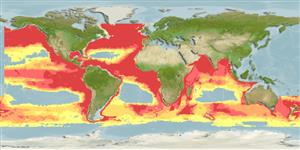Klassifizierung / Names
Namen | Synonyme | Catalog of Fishes (gen., sp.) | ITIS | CoL | WoRMS | Cloffa
Lebensraum / Klimazone / Range
Ökologie
; seewasser bathypelagisch; tiefenbereich 350 - 3000 m (Ref. 1371), usually 1300 - 2500 m (Ref. 5951). Deep-water, preferred 27°C (Ref. 107945); 62°N - 62°S, 180°W - 180°E
Circumglobal: Except the North Pacific north of 10°N. Reported from the Walvis Ridge and near the Discovery and Meteor seamounts (Ref. 44938).
Length at first maturity / Size / Gewicht / Alter
Maturity: Lm ?, range 41 - 43 cm
Max length : 75.0 cm SL Männchen/unbestimmt; (Ref. 5208)
Rückenflossenstacheln (insgesamt): 0; Rückenflossenweichstrahlen (insgesamt): 55-61; Afterflossenstacheln 0; Afterflossenweichstrahlen: 36 - 44; Wirbelzahl: 57 - 60. Blue-grey to blackish (Ref. 6606).
Found on the continental slope and upper rise (Ref. 6606). Epibenthic (Ref. 58426) and benthopelagic (Ref. 5951). Deep waters to 3277 m (Ref. 58426). May move offshore with age and spawn in the deep parts of its range. Off the eastern coast of United States, it is speculated that the population use the area only as feeding grounds with spawning taking place to the north. Feed on benthic invertebrates (Ref. 9319).
Life cycle and mating behavior
Geschlechtsreife | Fortpflanzung | Ablaichen | Eier | Fecundity | Larven
Cohen, D.M., T. Inada, T. Iwamoto and N. Scialabba, 1990. FAO species catalogue. Vol. 10. Gadiform fishes of the world (Order Gadiformes). An annotated and illustrated catalogue of cods, hakes, grenadiers and other gadiform fishes known to date. FAO Fish. Synop. 125(10). Rome: FAO. 442 p. (Ref. 1371)
IUCN Rote Liste Status (Ref. 115185)
CITES (Ref. 94142)
Not Evaluated
Bedrohung für Menschen
Harmless
Nutzung durch Menschen
Tools
Zusatzinformationen
Download XML
Internet Quellen
Estimates of some properties based on models
Phylogenetic diversity index (Ref.
82805): PD
50 = 0.7500 [Uniqueness, from 0.5 = low to 2.0 = high].
Bayesian length-weight: a=0.00219 (0.00141 - 0.00340), b=3.27 (3.14 - 3.40), in cm Total Length, based on LWR estimates for this species & (Sub)family-body (Ref.
93245).
Trophic Level (Ref.
69278): 3.6 ±0.47 se; Based on food items.
Widerstandsfähigkeit (Ref.
69278): mittel, Verdopplung der Population dauert 1,4 - 4,4 Jahre. (K=0.3).
Verwundbarkeit (Ref.
59153): High to very high vulnerability (71 of 100) .
